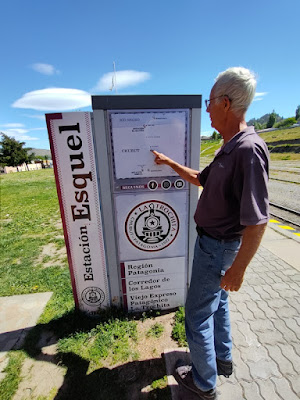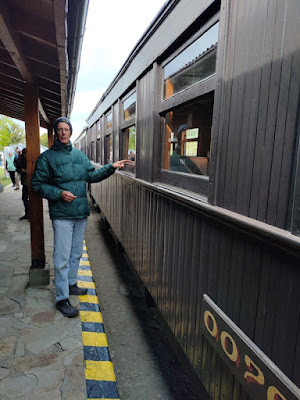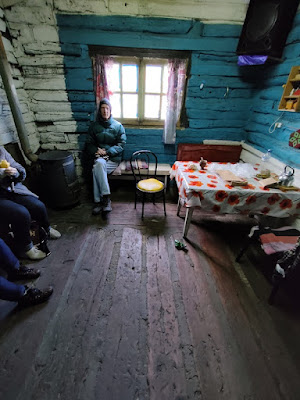We detoured off of Route 40 to find a place to stay in Esquel. The Old Patagonia Express train still runs here, after 101 years, so we stopped at the tourist info center to find out about riding it. It only runs on Saturdays at 10 AM, and since it was Friday afternoon, we found the travel agency that sold tickets and got the last two seats available for the train the next day. We went up to the train station, La Trochita, and saw a few cars but no engine. We'd have to wait for the next day.
The winds were smearing the clouds in the skies. We both thought his one looked like a space ship.Esquel is a quaint town, with lots of civic pride shown.
A lot of street art in many forms was visible along the roads.
A giant snowwoman greets drivers at the roundabout.
Jason outside our train car. We'd been warned it would be cold and windy, so we dressed for the wintery weather.
The train station at Esquel. You can just see the steam from the engine at the front of the train cars.
The train is run on fuel oil, but the heating in each train car is by these little wood stoves called 'the salamanders'.
The wood box across from the salamander. Yes, it has real wood in it to burn.
Leaving the station, we looked back to see a big mural on the end of the station building.
My ticket for the ride. Tiny piece of cardboard. A conductor did come by and punch it, though
The track rode above the town. The Axion station where we stayed is right below us behind those trees.
Scenic mountain view as we left town, heading west, then southwest. The trip was only about 20kms, but took about an hour. Slow traveling.
Jason feeding the salamander. Our seats were right next to it--cozy and warm.
On an S-curve, you could lean out and see the engine ahead. You can tell the wind is blowing by the horizontal smoke.
Jason leaning out the window for pictures. The wind was cold and the single-pane windows rattled when they were closed.
Looking forward from our train car window.
Karen and Jason warm and snuggly in our seats by the salamander.
The destination was Nahuel Pan, a little cluster of indigenous homes with a tiny museum and an artisan hall. The homes are made of timbers.
Another view of a home here.
The station sign at Nahuel Pan. This is all there is of the place.
This lady was braving the cold, strong winds to sell empanadas and we scarfed down two apiece. Delicious. Lilacs are in bloom here, too. One of my favorite spring flowers.
More timber buildings as we came into Nahuel Pan. These were railroad maintenance buildings.
Empanadas weren't enough to fill us for lunch so we went to the next building and bought some tortas fritas, basically fried bread that poofs up. Close to a plain raised donut but not as sweet. We're waiting inside out of the wind while the lady bags us a dozen pieces for about $1.50. Interesting paint job.
Jason gobbling some tortas fritas. They filled the spot and we nibbled them all the way back, leaving only 3 left for dinner.
Jason spotted some tambourines on the wall and did his Saturday Night 'Stayin Alive' dance, to the amusement of the lady owner.
The tambourines back on the wall where they belong.
In the artisan hall, there were lots of woven hats, socks, scarves and such, along with yerba mate drink cups and some stone jewelry. This loom was a work in progress for a scarf for when there weren't tourists in the building.
Our engine, No. 1, was built in North America in 1922.
The front of the engine sports a yellow cow catcher, but is probably used more for snow removal when it runs in winter.
The orange under the train is real flames. The train uses about 100 liters of water every kilometer and the copper pipes running from the engine to other parts of the locomotive dripped water and steam even as we sat still.
The front nose of Engine No. 1.
Our engineer driver for the Old Patagonia Express. It used to be used to haul goods and people to a bigger-gauged train that ran to Buenos Aires from El Maiten, about 120 kms. away to the north.
Prior to the train, goods were hauled via ox and mule carts. Now the train is only for tourists, parts are hand made when needed, and it no longer runs to El Maiten as the provinces can't afford to maintain the tracks.
A few sheep behind one of the buildings in Nahuel Pan. Not much out here.
The locomotive was uncoupled from the cars and went around a loop to get back to the other end of the train cars for the return trip.
The staff had their own car, with wooden bench seats in stead of our padded leather ones. But they had a big double wood stove and were heating water for yerba mate and their tortas fritas on it. Staff narrated the history of the train as we rode (in Spanish only). A lady at the station in Esquel heard me speaking English and sent me the verbal history via WhatsApp to my phone so we could learn what she was telling the rest of the passengers.
The wood stove in the staff car also acted as their kitchen and kept the car warm.
The locomotive backed up to recouple with the passenger cars. Original passenger cars had toilets and armrests on the seats. Ours was a repurposed cargo car that had padded seats and a salamander, but no armrests or toilet.
Jason playing the man thrown onto the tracks to be run over.
The steam whistle let off a lot of steam, which was blown horizontal by the strong winds.
These guys in the white pickup truck are the crossing guards. There are no gates where the train tracks cross the highway or local roads. They waited until the train was ready to depart, then raced ahead to stop traffic.
The crossing guards with their red flags stop traffic on Route 40 until the train passes.
We've seen this camper van a few times. A Ford truck about the same color as ours with OMAN on the side. We'll have to share this photo with them as we passed them while on the train.
The salamander was hungry this day and the guide lady let passengers feed the wood to if if desired.
Big healthy horses in a pen along the tracks. One of them had kicked open the gate posts and they were all in the process of escaping to run about. We just hope they didn't get into traffic.
You can barely see the engine as we go around the curve, but the line of steam/smoke tells where it is.
Old cargo cars back at the Esquel station. On the road above the station, there were people and cars lining the roadway, having a market day.
We'd stuck around Esquel for a few days in order to have the Ford Service garage look into our Service Engine Soon light issue. It had come on again after the garage in Bariloche had scanned the engine and cleared the light. We tried to buy a new spark plug but they don't sell the one we need in this country as they don't have our engine in the vehicles in this country. So we were hoping the service manager could pull the plug and check for corrosion or problems. He was willing to do it immediately, but we had a train to catch and the next time the would be open was Monday at 9 AM. We stayed over the weekend, but then the light was gone so we didn't take it in to the service garage. Instead we took our laundry in to be washed and had to go to three to find one that was reasonably priced and could do it the same day. With clean clothes and sheets, we'll be off to head farther south.
























































































